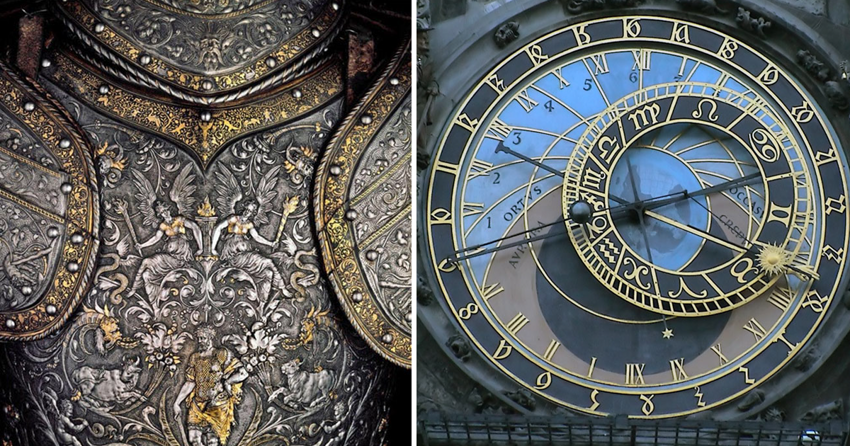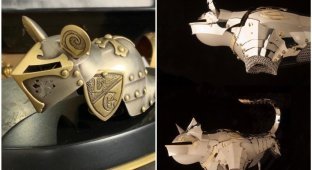25 ancient buildings and things that still fascinate us (26 photos)
It is amazing how humanity has advanced over the past centuries, decades and even years. Science is developing faster than ever, new inventions appear every day, and we only think about what awaits us tomorrow. But sometimes it’s interesting to turn to the achievements of the past, when opportunities were limited, but this did not stop talented creators. Here are some amazing artifacts that have survived to this day and still fascinate people. 
1. Stunning armor made in 1555 
Nicknamed the Armor of Hercules, this armor was made in the mid-16th century for Archduke (and later Holy Roman Emperor) Maximilian II. The armor is decorated with patterns and mythological motifs. They were made in France, and judging by the exquisite details, they were not intended for military action, but were supposed to indicate Maximilian's high position at court.
2. An ancient Egyptian ring that dates back to approximately 1070-712. BC. 
This gold ring, decorated with a cat figurine made of semi-precious carnelian stone, is at least 2,700 years old. On the inside of the ring, under the cat figurine, is carved the Wadjet symbol, also known as the Eye of Horus - a powerful protective amulet.
3. 3400-year-old Egyptian artist's palette 
This palette is carved from a single piece of ivory. It still contains pigments of blue, green, brown, yellow, red and black, although it was made around 1390-1352 BC. The palette is also decorated with hieroglyphs with the name of Pharaoh Amenhotep III and the phrase “beloved of Ra.”
4. A 2,000-year-old ring that may have belonged to Caligula 
This stunning ring is a hololith, meaning it is made from a single piece of stone, in this case sapphire. It is believed to have belonged to the Roman Emperor Caligula, who reigned from 37 to 41 AD, and the woman engraved on the ring is Caesonia, the emperor's fourth and final wife. The ring was put up for sale in 2019, and while it's not revealed who owned it or for what price, it is rumored to have fetched around $600,000.
5. An Ostrich Egg Globe That Has Survived Half a Millennium 
Scientists believe that this globe was made around 1510, making it the oldest map depicting the New World. The map is carved on a grapefruit-sized ostrich egg, which is highly unusual as such maps were usually carved on calfskin, sealskin or wood. It is possible that the map was made for a noble Italian family, and it is believed that it has something to do with Leonardo da Vinci himself, since it was made in Florence and depicts a ship similar to those painted by an artist associated with da Vinci. It is quite possible that the author of the globe was either inspired by da Vinci or worked in his workshop.
6. 2400-year-old shoes found in the Altai Mountains 
It wasn't just the Romans who wore fashionable shoes. During excavations of ancient graves in the Altai Mountains, archaeologists discovered an even more ancient pair of shoes, which were perfectly preserved. This stylish shoe was worn by Scythian women around 300-290 BC. The shoes are made of leather, fabric, pewter and gold. It is well preserved due to the low temperatures in the area and the frozen ground.
7. A 2,000-year-old temple that still stands today 
The Temple of Hathor is one of the best preserved in Egypt and the main one in the Dandara temple complex. Amazingly, the colors inside are still vibrant, even though everything inside was once covered in soot. What’s even more surprising is how well all the patterns are preserved, since the temple is already more than 2,000 years old. It was built under Queen Cleopatra VII from approximately 54 to 20 BC.
8. Arcadico Bridge, built between 1300 and 1190 BC. 
MoThe Arkadiko stu in Greece is over 3,300 years old, making it one of the oldest today - and it is still in use today! It once connected two ancient Greek cities of the Bronze Age - Tiryns and Epidaurus. The 22-meter-long bridge was built with a cyclopean masonry of limestone boulders, smaller stones and small pieces of tile, tightly packed together without the use of mortar - a typical masonry of Mycenaean architecture.
9. “Christ under the Shroud” by Giuseppe Sanmartino, 1753 
"Christ in the Shroud" is one of the most famous and outstanding works of art in the world. The young Neapolitan sculptor Giuseppe Sanmartino created it in 1753. The most outstanding detail of the sculpture is the veil, which appears transparent, although it is also made of stone. It looks so realistic that for a long time there was a legend that the veil was once real and over time petrified as a result of a chemical process. Experts studied it and confirmed that the entire sculpture was made of marble.
10. Wooden figurine of Death, 1520 
In English and German culture, Death is represented as a man, and in French and Italian culture - as a woman. The 16th century sculptor Hans Leinberger presented Death as a skeleton - the personification of what happens to a person after his death. The figure holds arrows in one hand and a bow in the other. The figurine is carved from a single piece of pear wood, which testifies to the extraordinary abilities of the master.
11. 2000-year-old Roman shoe 
Don't let the suspiciously familiar design confuse you: this stylish shoe was actually made back in the first centuries of our era. It was discovered at the bottom of a well in the Roman fortress of Saalburg in Germany. Women's shoes of that time were decorated with embroidery, patterns and lace, which testified not only to the talent of the master, but also to the status and wealth of the owner.
12. The astronomical clock in Prague has been in operation since 1410 
This wonderful clock will be 611 years old in October, making it the third oldest astronomical clock in the world, but also the oldest still in operation. The watch is completely mechanical and shows the relative positions of the Sun, Moon, Zodiac constellations, and sometimes other planets. Of course, they also show the time and date. Every hour there is a mini-performance: Death turns over the hourglass, then the figures of the 12 apostles appear and bow to the audience. The performance ends with the cry of a raven and the chimes. In Prague there is a belief that if something happens to the clock, the skeletal figure of Death will nod its head and Prague will suffer grief. Because of this legend, the people of Prague willingly donated wood to repair clocks when they were damaged during the war in 1945, although there was a great shortage of this material in the country at that time.
13. A child's footprint on a 2,000-year-old clay tile 
In the small French town of Vaison-la-Romaine, a piece of Roman clay tile was discovered with the footprint of a small child. Apparently the child stepped on the tile while it was still drying, suggesting that childhood curiosity goes back at least 2,000 years.
14. The seal on Tutankhamun's tomb that remained untouched for 3,245 years 
The tomb of the ancient Egyptian pharaoh Tutankhamun was discovered in 1922. The whole world talked about the discovery, since the tomb was perfectly preserved and full of treasures: jewelry, statues, a chariot, weapons, clothes - everything lay untouched for more than 3,000 years. Do you know what else remained untouched? Seal on the tomb doors. This rope protected the pharaoh's tomb for three millennia until it was torn apart in the last century.
15. Book-pistol of the 17th century 
Knowledge can be not only power, but also a weapon. An amazing prayer pistol was made to order for Francesco Morosini, Duke of Venice, who lived from 1619 to 1694. The mechanism was designed in such a way that the book could only be fired when it was closed. Most likely, this unusual weapon was used for self-defense.
16. Sign “Beware, angry dog!” in a 2000 year old house 
The mosaic in the photo above was discovered in the "House of the Tragic Poet" in Pompeii, which dates back to around the 2nd century BC. The image of the dog is captioned with the phrase “cave canem,” which is Latin for “beware of the dog.” Modern signs on fences are far from this masterpiece!
17. Esoteric ritual dagger of the 19th century with the image of death 
This unique dagger, which may have been used in esoteric rituals, sold at auction for 4,700 euros. The lot description states that the long bronze dagger was made in France in the 19th century. The handle depicts Death with a snake at his feet. The blade is also rich in detail: it is engraved with floral patterns, and you can also see a snake, an eagle and an owl. Floral patterns are also repeated on the brass details of the wooden scabbard that was sold with the dagger.
18. 2500-year-old sword that belonged to Goujian, the ruler of the ancient kingdom of Yue 
This ancient sword belonged to Goujian, who ruled the Yue Kingdom from 496 to 465 BC. The symbols on the sword spell out the words "King of Yue" and "made this sword for [his] personal use." The sword was found in its scabbard, so it was practically undamaged. The sword is made mostly of copper, but there is more tin in the blade, which explains why it is still sharp.
19. Floor of a Roman villa of the 3rd century 
Scientists have discovered evidence of a Roman villa near Verona almost a century ago, and only recently have its ruins been finally found. Archaeologists discovered a 3rd century mosaic in 2020 at a private vineyard in the town of Negrar di Valpolicella. They believe that this mosaic is the floor of the Domus, the home of wealthy owners. The tiles are in perfect condition, the colors are still vibrant and the patterns are easily discernible. When the excavations are completed, the villa will be opened to the public.
20. A wall with a dodecagonal stone in Peru looks the same as it did hundreds of years ago. 
It is not known exactly when this wall was built, but it once surrounded the now destroyed Incan palace. The stones that make up the wall have twelve, five, six and seven corners, so putting them all together was no easy task. The stones are connected very tightly and even now, hundreds of years later, you cannot even insert a sheet of paper between them. The structure had to be stable as the area was prone to earthquakes, and we can now confidently say that the wall has stood the test of time. The dodecagonal stone was even declared a national heritage site of Peru.
21. 19th century staircase in a French castle 
Chantilly is a castle in France, near Paris. Its construction began in the mid-14th century and was completed at the end of the 19th century, since it consists of two parts, which were built alternately: the Small Castle and the New Castle. The staircase in the photo is in the lobby of the New Castle and leads to small apartments. The castle was destroyed during the revolution, and in the 19th century (approximately between 1875 and 1882) the Moreau brothers rebuilt it according to the design of the architect Honore Maison, and this wonderful staircase is just his creation.
22. 9,000-Year-Old Cave Art Depicts the Psychedelic Effects of Mushrooms 
The Tassilien-Adjer National Park in the Sahara Desert is the most important rock art site. Petroglyphs ranging from four to nine thousand years old were found in these caves, and some large images of animals are even more than 12,000 years old. But one 9,000-year-old drawing deserves special attention - it depicts a shaman with a wasp-shaped head. In his hands he holds mushrooms, which also grow from his body. Based on this, scientists suggested that the drawing depicts the psychedelic effects caused by eating mushrooms.
23. Byzantine-era funeral tablet found by a teenager 
13-year-old Stav Meir and his family went in search of mushrooms, but found something more interesting. He noticed a stone sticking out of the ground, which turned out to be a funeral tablet from the Byzantine era with an inscription in Greek, approximately 1,500 years old. For this unique find, the Israeli authorities awarded the boy a certificate of honor.Ouch. The Israel Antiquities Authority believes the stone adorned the grave of a wealthy man. It was possible to make out only part of the name on the tablet, so it is unknown whether the grave belonged to Anastasia or Anastasia.
24. An old weapon from the 16th century that served as a dagger, a pistol and a calendar at the same time 
In the 16th century, gunsmiths thought it would be a good idea to combine a pistol with a sword, dagger, ax or even a crossbow, so that the owner of the weapon could protect himself if the pistol suddenly misfired. But such combo weapons turned out to be inconvenient to use and impractical. The photo above shows a hunting knife combined with a wheel lock pistol. The weapon was made by the German engraver Ambrosius Gemlich, and it consisted of two parts: a blade with an engraved calendar for the years 1529-34 and a pistol barrel, which dates back to 1540 or 1546.
25. Mortar of the late 18th century in the form of a tiger 
This mortar was made in India around 1770–1799. It may have been made specifically for Tipu Sultan, who was nicknamed the “Tiger of Mysore” and lived from 1753 to 1799. However, the mortar was not completed, and in its current state it does not work, but according to the idea, the cannonballs were supposed to fly out of the tiger’s mouth in order to intimidate the enemy even more.























